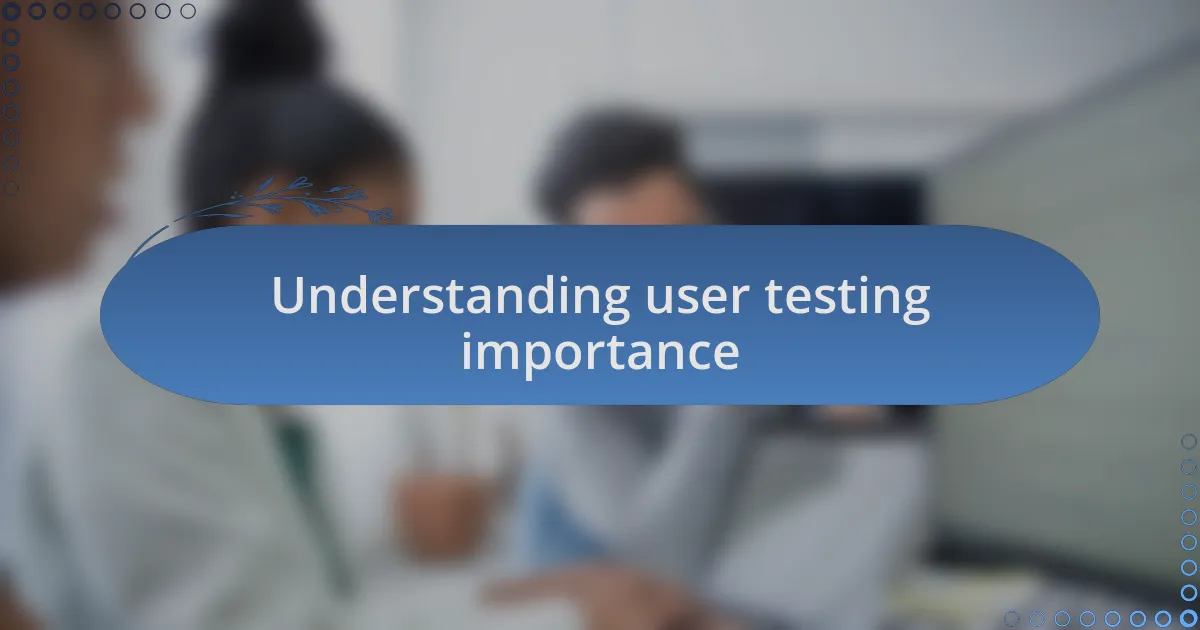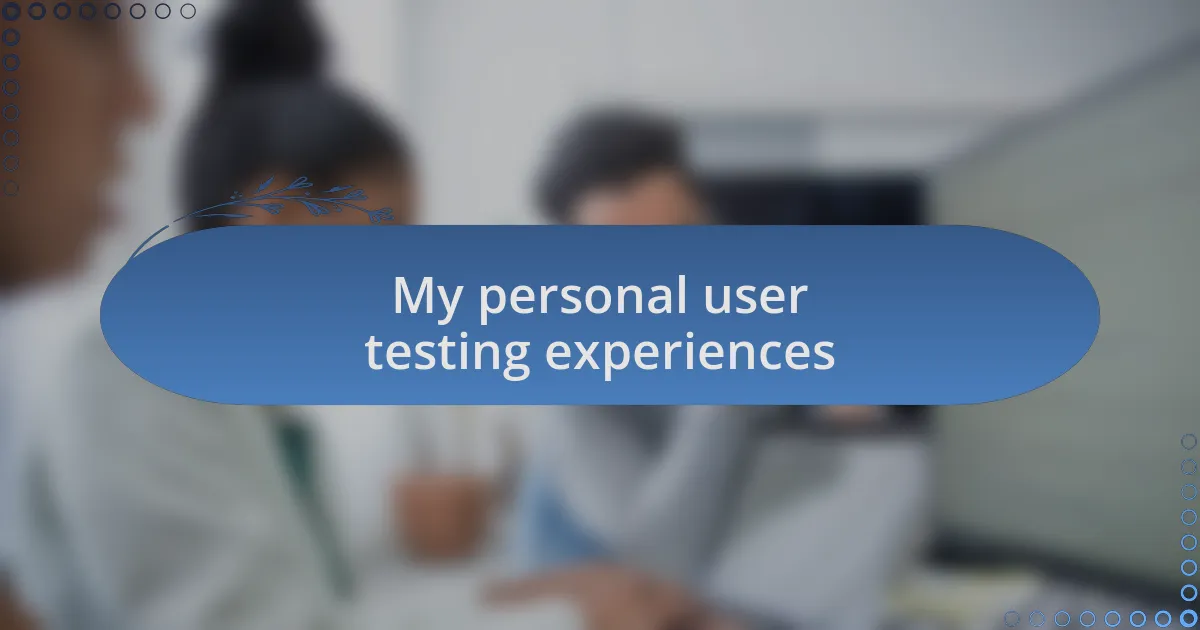Key takeaways:
- User testing reveals critical insights into usability that can significantly improve the user experience and align design with user needs.
- Effective user testing benefits from careful participant selection and documentation, ensuring that relevant insights are captured and analyzed.
- Clear goals and a welcoming environment during testing are essential to obtain valuable and honest user feedback.
- Timing and presentation quality of the product during testing can greatly influence user perception and feedback received.

Understanding user testing importance
User testing plays a crucial role in uncovering the true user experience on a website. I remember a project where initial designs looked visually appealing, but user testing revealed that navigation confused visitors. This not only wasted time but also highlighted the importance of aligning design aesthetics with usability.
When I conduct user testing, it feels like opening a door to a room filled with insights. Have you ever watched a user struggle with a feature you thought was intuitive? Those moments can be tough but incredibly enlightening, often reshaping the final product to better meet the audience’s needs. It’s in those awkward pauses and puzzled expressions that I find the true power of user feedback.
The emotional weight of user testing cannot be overstated. Each test is not just data collection; it’s a chance to hear your audience’s voice. I often leave these sessions feeling a surge of responsibility to create something meaningful, turning real-world frustrations into actionable improvements. This connection transforms how I approach development, reminding me that every click and scroll tells a story worth listening to.

Key benefits of user testing
User testing offers a wealth of benefits that can elevate the user experience significantly. For instance, I recall a project where preliminary feedback highlighted a critical bottleneck in the checkout process. By refining that part of the journey based on real user interactions, we not only boosted conversion rates but also decreased cart abandonment—a win-win situation that many developers overlook.
One of the most rewarding aspects of user testing is how it uncovers user needs that we often miss in our own assumptions. Have you ever been so immersed in a project that you forgot to step back and see it from an outsider’s eyes? I have, and that’s why conducting tests feels like a revelation. The insights gained from users who are experiencing the product for the first time can lead to unexpected improvements.
Additionally, user testing helps build a more empathetic connection with the audience. I find that each session reveals a unique perspective that I hadn’t considered before. It’s a reminder that behind every click, there’s a human being with desires, needs, and frustrations. How often do we consider the emotional journey of a user navigating our websites? Every time I witness a user struggle, it spurs me to make changes that not only enhance functionality but also resonate with users’ emotions.

Best practices for user testing
When it comes to user testing, one of the best practices I’ve learned is to keep the sessions focused and targeted. I remember a time when I conducted tests with a diverse group of users all at once. It was overwhelming! But once I started segmenting participants based on specific demographics or use cases, the feedback I received became much richer and more actionable. Have you ever tried narrowing down your audience in a testing scenario? It can make all the difference.
Another essential practice is to encourage users to vocalize their thoughts while navigating your site. During one testing session that I facilitated, I asked participants to think aloud, and their insights were phenomenal. Hearing them articulate their thought processes provided me with context I would have never anticipated otherwise. It’s fascinating how words can unlock hidden pain points and opportunities for improvement—have you ever had a moment like that?
Lastly, documenting user testing sessions is crucial. I can’t stress enough how valuable it is to have recordings or detailed notes afterward. In one project, I revisited recordings weeks later and discovered nuances I had initially missed. This practice allows me to spot patterns and trends over time. Have you ever gone back to old sessions and found insights that changed your approach? It’s a game changer for refining future projects.

Common pitfalls in user testing
One common pitfall I’ve encountered in user testing is a lack of defined goals. Early in my career, I participated in a project without a clear objective, and the results were confusing. I remember feeling frustrated; without knowing what we were specifically looking for, the feedback was scattered and not particularly useful. Have you ever felt lost in a testing session without a clear direction? It can lead to wasted time and effort.
Another issue is not reaching out to the right users. There was a time when I assumed that anyone could provide valuable insights on a website targeting professionals in a niche industry. The results were disheartening, as the feedback came from individuals with little context to the actual use case. This experience taught me that choosing participants who truly understand the product is crucial. Without the right insights, how can you be confident that your website meets the needs of its intended audience? It’s a lesson I carry with me in every testing phase.
Moreover, I’ve noticed that skipping the analysis phase often leads to missed opportunities. In one project, after conducting what I thought was thorough testing, I rushed through the analysis. Later, I discovered critical feedback I had glossed over initially. It felt like a missed chance to enhance the site meaningfully. Have you ever hurried through a step only to realize later that slowing down could have yielded valuable insights? Taking that time can transform the outcome of your project.

My personal user testing experiences
During a recent user testing session, I vividly recall the anxiety of introducing a prototype that I believed had the potential to shine. As users navigated the interface, I felt a mix of hope and dread; their reactions were like a mirror reflecting my design intentions, yet their confusion indicated I had failed to communicate effectively. Have you ever held your breath, waiting for feedback, only to hear that what you thought was clear left others puzzled? It made me realize that testing isn’t just about observing; it’s about understanding the user’s perspective deeply.
I once conducted a test with a group of participants who represented various demographics. While it seemed like a great idea to gather diverse opinions, I quickly discovered that not everyone felt comfortable sharing their thoughts openly. I watched as some users hesitated, unsure if their feedback would resonate. It struck me that creating a welcoming environment is just as crucial as the actual test. Have you experienced that subtle shift in energy when a participant feels at ease? That comfort can unlock insights that will otherwise remain hidden.
There was a project where I attempted to test a new feature on my website but underestimated the time needed for sufficient user engagement. I recall feeling a sense of urgency pressing down on me, pushing me to expedite the process. Ultimately, I learned that rushing leads to surface-level feedback. Have you felt that pressure, only to realize later that a little patience can lead to richer, more meaningful insights? It’s a reminder that user testing is an ongoing journey, where every interaction and reflection count towards building something truly useful.

Lessons learned from user testing
User testing taught me the undeniable value of clear communication. I remember watching a participant’s face transform from confusion to clarity when I offered a simple explanation of a confusing feature. This interaction sparked an important realization: users often need guidance more than I initially assumed. Have you ever noticed how a slight adjustment in your wording can shift someone’s entire understanding? This experience helped me refine not only my designs but also my approach to presenting them.
Another lesson came from observing how participants reacted to design elements I was particularly proud of. I expected enthusiasm but was met with indifference. It was a humbling moment, as it highlighted my bias; I was emotionally invested in certain features that didn’t resonate with users. This made me reflect: how often do we fall in love with our own creations, forgetting that the true measure of success lies in users’ experiences? It’s essential to remain objective and prioritize user feedback over personal attachment.
I also learned the hard way that sometimes timing is everything. During a testing session, we presented a product in its beta stage, only to find that users were frustrated by minor glitches. I’ve felt that sinking feeling when excitement turns to disappointment, and it taught me the importance of presenting a polished experience. Have you ever felt the weight of unmet expectations? This reinforced my belief that user testing should take place when the product is ready to shine, allowing for genuine feedback that can elevate the design to new heights.